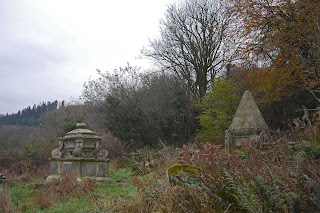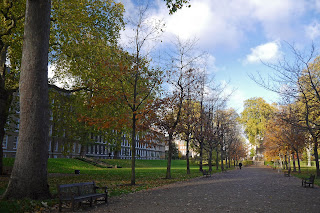Tintern Abbey
We were guided by cousins Ruth and Jon on this fascinating walk from the imposing ruins of Tintern Abbey. The abbey was founded in 1131 and is the second oldest Cistercian abbey in the Britain (only Waverley in Surrey is older). The original buildings would have been austere, but the church whose remains you now see is the result of a grand reconstruction which began in 1269. By the time the abbey was dissolved in 1536 it was the wealthiest in Wales.
We walked away from the abbey, crossed the road and climbed up to more ruins, those of St Mary's church built in 1866 to replace a medieval chapel and burnt down in 1977.
The sloping churchyard contains some impressive 18th and 19th century graves.
A series of narrow paths led us through scattered houses and we especially liked the oriental statues on the gateposts of one of these.
We entered some nice beechwoods on one slope of the Angidy River valley ...
... and descended to a small bridge over the river.
This river valley developed as an important industrial centre from the late 16th century and there were numerous water-powered works along its route. The most conspicuous now is the abbey bast furnace, where the location of the water wheel is readily identifiable.
We walked up through Buckle Wood to a hamlet marked on the map as Fairoak and then along the road and across fields to reach the Gare Hill WT station at 260m above sea level. There was a great view, unfortunately very grey and hazy today, down over the Severn, with both the Old and the New Severn bridges clearly visible.
We retraced our steps and now enjoyed a splendid view towards the Wye valley.
As we descended towards the valley we passed the tiny church of St Mary's at Penterry. The walls are medieval but the porch and bellcote are the result of a Victorian renovation. On the north side there is a medieval leper window, a lancet at a low level that allowed lepers to view services without coming into contact with other members of the congregation.
After crossing some fields, we descended through Limekiln Woods, soon passing the eponymous lime kilns. These ones were used from the 1700s until 1902.
Scrambling up the bank of the sunken track allowed me this view of the abbey as we approached
We also saw this intriguing and mysterious fungi.
And finally some mummers (?) were performing outside the Anchor Tea Rooms, which provided an unusual end to a very interesting walk.
Conditions: cloudy, grey, cold.
Distance: 5 miles.
Map: OL 14 (Wye Valley & Forest of Dean).
Rating: four stars



















































